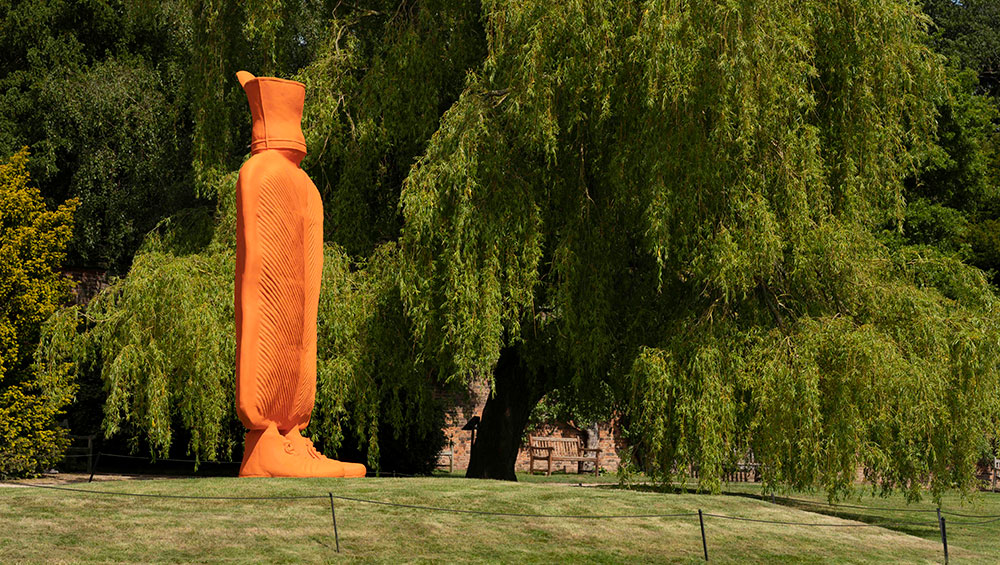
Erwin Wurm, Big Mutter, 2015. Installation view at Yorkshire Sculpture Park, 2023. Courtesy Studio Erwin Wurm and Thaddaeus Ropac Gallery. Photo: © Jonty Wilde, courtesy YSP.
Yorkshire Sculpture Park
10 June 2023 – 28 April 2024
by DAVID TRIGG
A giant hot water bottle with bright orange feet towers over visitors in the grounds of Yorkshire Sculpture Park (YSP), ostensibly surveying the verdant landscape. Nearby, a briefcase and a suitcase with long, slender legs appear to be throwing shapes as if on a dance floor while, elsewhere, three anthropomorphic sausages frolic on a lawn. Absurd, surreal and humorous, these strange sights feature among the 19 large outdoor sculptures that Erwin Wurm has placed around YSP’s historic parkland as part of Trap of the Truth, the Austrian artist’s first major UK museum exhibition, surveying more than 30 years of his quirky, convention-defying sculptures.
Wurm’s works regularly raise a smile, yet he insists that humour is merely a by-product that arises from looking at the world askew. Levity may provide a way into his sculptures, but beyond that are deeper meanings born of serious intent. Take for instance the 5-metre-tall Step (Big) (2021), a luxury pastel-blue Hermès Birkin bag that has been anthropomorphised with long, spindly legs. Part of Wurm’s Bags series, the sculpture’s silliness prods at high-end consumer culture and ponders the impact that production and consumption have on identity formation – how we see ourselves and how we are seen by others. Like many of his works, it speaks to the dominance of materialism in our culture and the pressure to conform to societal expectations.
,-2021.jpg)
Erwin Wurm, Step (Big), 2021. Installation at Yorkshire Sculpture Park, 2023. Courtesy Studio Erwin Wurm and Thaddaeus Ropac Gallery. Photo: © Jonty Wilde, courtesy YSP.
When it comes to status symbols and projections of identity, cars rank high on the list, and they have played a significant part in Wurm’s practice since the early 1990s. His Fat Car series includes some of his best-known works, including Convertible Fat Car (Porsche) (2006), for which a real sports car was plumped up with Styrofoam and fibreglass, its sleek lines hidden under layers of flab. Wurm has explained that the title of the series relates to the German phrase “fettes auto” (comparable to the English term “fat cats”), a slang expression for luxury cars bought by wealthy people. But in these hypersensitive times, Wurm’s overweight cars are becoming harder to exhibit. Despite their cutting critique of consumer culture and greed, they are, disappointingly, not welcome at venues such as YSP lest they cause offence.
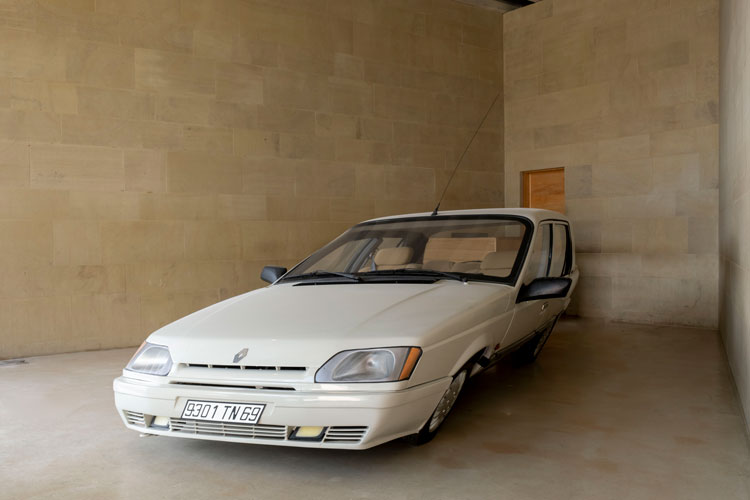
Erwin Wurm, Renault 25, 1991. Installation view at Yorkshire Sculpture Park, 2023. Courtesy Studio Erwin Wurm and Thaddaeus Ropac Gallery. Photo © Jonty Wilde, courtesy YSP.
Among Wurm’s less controversial vehicles is Renault 25 (1991), which has been painstakingly modified to appear cartoon-like, leaning to one side as if speeding around a corner. Philosophy underpins many works here and we are told that this wonky automobile is intended as a tribute to Gilles Deleuze (1925-95) and his book on film theory Cinéma I: L’image-mouvement (1983), though the connection between Wurm’s sculpture and the French theorist’s text is not elucidated.
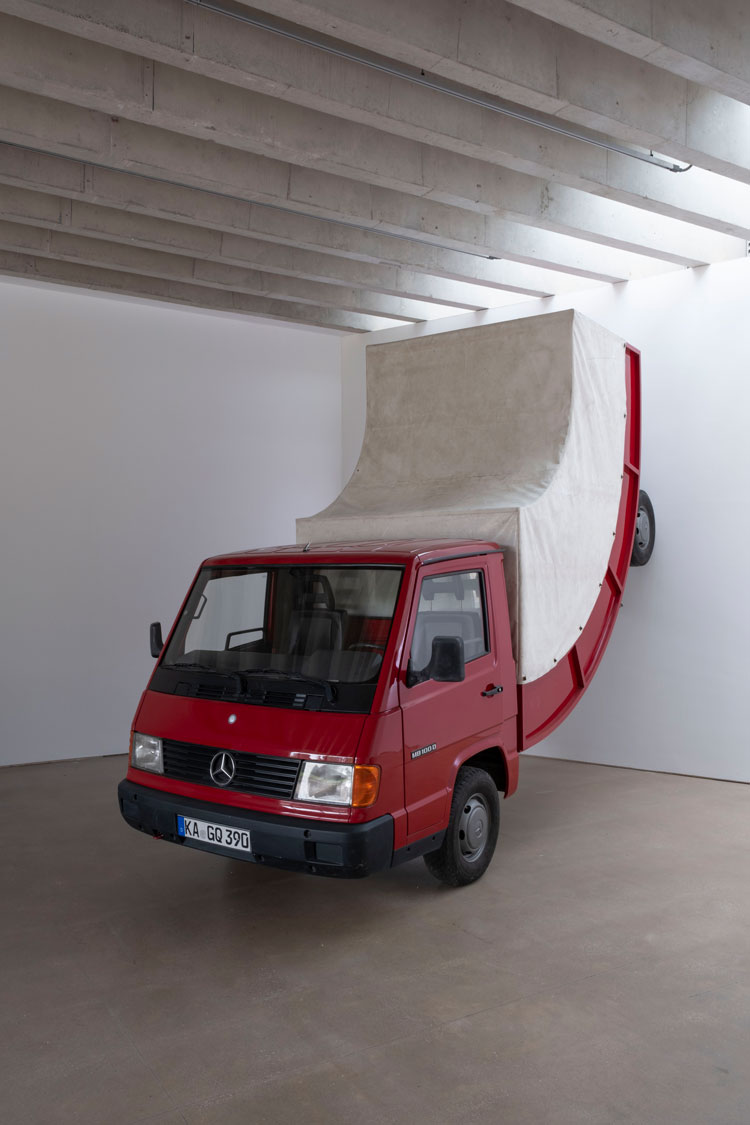
Erwin Wurm, Truck II, 2011. Installation view at Yorkshire Sculpture Park, 2023. Courtesy Studio Erwin Wurm and Thaddaeus Ropac Gallery. Photo: © Jonty Wilde, courtesy YSP.
In another room is the extraordinary gravity-defying Truck II (2011), a Mercedes Benz MB-100 truck that Wurm has bent like a banana and apparently reversed up the gallery wall. Outside, The German Couch (2021) comprises a Mercedes-Benz W123 made from aluminium, but which has been compressed on one side; transformed into a psychoanalyst’s couch (Sigmund Freud is another big influence on Wurm), it draws links between cars and subconscious desires.
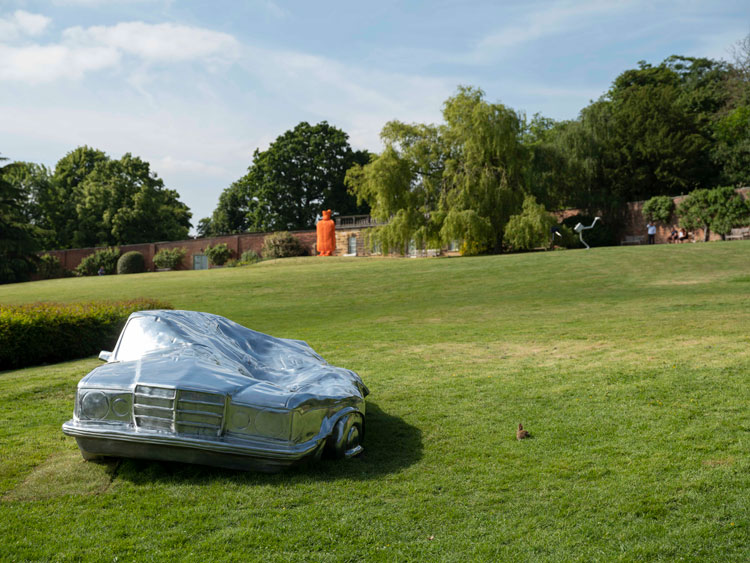
Erwin Wurm, Installation view of Trap of the Truth at Yorkshire Sculpture Park, 2023. Courtesy Studio Erwin Wurm and Thaddaeus Ropac Gallery. Photo: © Jonty Wilde, courtesy YSP.
The distortion and manipulation of everyday objects continues inside YSP’s Underground Gallery with sculptures of Frank Lloyd Wright’s Guggenheim Museum and Daniel Burnham’s Flatiron Building in New York, which appear to be melting like ice-cream – fantastical, dreamlike scenarios that again call into question our certainties about material reality. Wurm’s iconoclasm takes a comically violent turn in The Attacks (2022), his series of cars and houses that have apparently been destroyed by giant sausages and bananas. While they read like scenes from an improbable B-movie, the phallic nature of the car-crushing comestibles recalls JG Ballard’s provocative 1973 novel Crash, a cautionary tale about sexual obsession and technological seduction. Wurm’s smashed buildings, on the other hand, are based on the homes of philosophers and writers, such as Ludwig Wittgenstein, Martin Heidegger and Henry David Thoreau. It is hard to tell if Wurm is mocking these revered figures or playfully honouring them. Such ambiguities are a common and frustrating aspect of his practice.
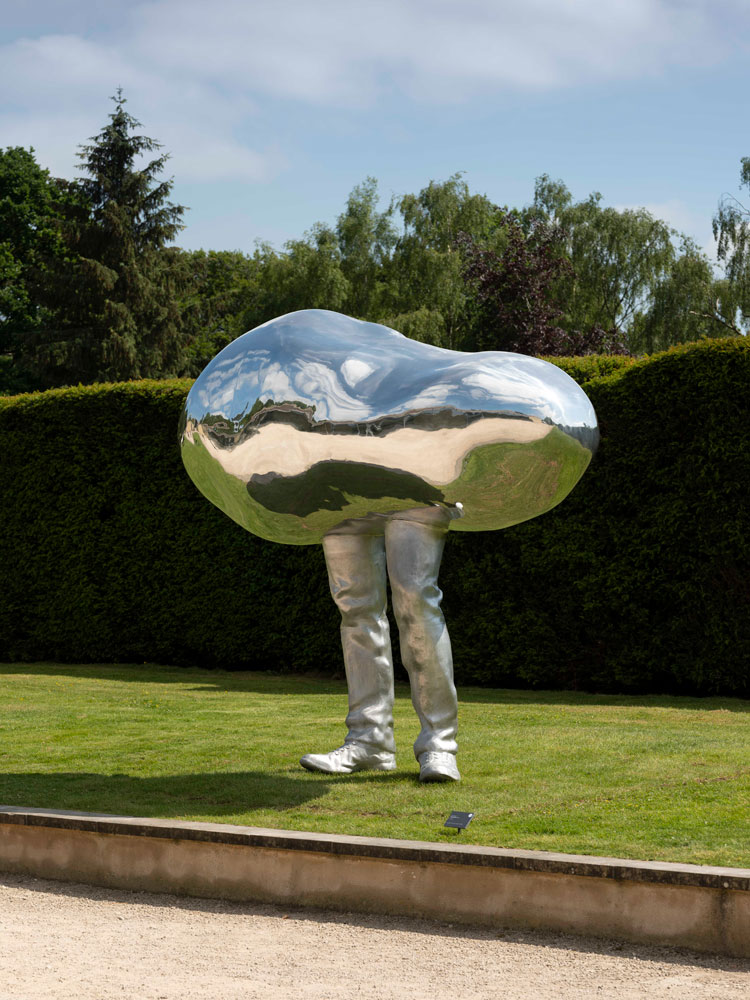
Erwin Wurm, Big Hypnosis, 2008. Installation view at Yorkshire Sculpture Park, 2023. Courtesy Studio Erwin Wurm and Thaddaeus Ropac Gallery. Photo: © Jonty Wilde, courtesy YSP.
Many of Wurm’s works revel in incongruity and awkwardness. This is best exemplified by his ongoing series of One Minute Sculptures, which since the late 1980s have encouraged viewers to become participants by transforming themselves into artworks for a few moments. Written or drawn instructions directing people to pose with everyday objects result in funny, bizarre and often embarrassing situations which, given their precariousness, are usually sustained for no more than a minute. The series began as an attempt to find a way of representing in sculpture concepts such as embarrassment, ridicule or desire. At YSP, visitors are invited to clamber on to a kitchen sink, create a bridge across two orange stools, or rest their heads under a low-hanging pendulum lamp. These transitory pieces negate the boundary between artwork and viewer, colliding the everyday and the philosophical while confounding our expectations of what a sculpture can be. A wall of related drawings shows figures carrying furniture on their backs, balancing buckets on their shoulders, and placing shoes on top of poles.

Erwin Wurm, Ship of Fools, 2017. Installation at Yorkshire Sculpture Park, 2023. Courtesy Studio Erwin Wurm and Thaddaeus Ropac Gallery. Photo: © Jonty Wilde, courtesy YSP.
The largest of Wurm’s One Minute Sculptures is Ship of Fools (2017), a rickety 1960s caravan with which visitors are invited to interact by climbing inside and placing their heads, hands, backsides or feet through various apertures cut into its sides. Disregarding the norms of the gallery, these comical and eccentric performances feel transgressive. The work’s title evokes Sebastian Brant’s 1494 satire Das Narrenschiff (The Ship of Fools), one of the most important works of 15th-century German literature, which mocked politicians, clerics and others in society with an irreverent wit. The One Minute Sculptures similarly employ absurdity to probe the conventions and idiosyncrasies of modern western society while simultaneously interrogating the fundamentals of sculpture: space, line, proportion, texture, colour, mass and, above all, form. It is this careful balance of social and aesthetic concerns that gives Wurm’s work its broad appeal and prevents his whimsical approach from descending into outright farce.